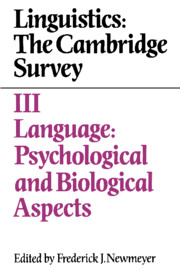Book contents
- Frontmatter
- Contents
- Contributors
- Preface
- 1 Psycholinguistics: an overview
- 2 Language and cognition
- 3 Processes in language production
- 4 Language perception
- 5 The mental lexicon
- 6 Where learning begins: initial representations for language learning
- 7 Second language acquisition
- 8 Neurolinguistics: an overview of language–brain relations in aphasia
- 9 The biological basis for language
- 10 Linguistics and speech–language pathology
- 11 The evolution of human communicative behavior
- 12 Linguistics and animal communication
- Index of names
- Index of subjects
- Contents of Volumes I, II, and IV
10 - Linguistics and speech–language pathology
Published online by Cambridge University Press: 03 February 2010
- Frontmatter
- Contents
- Contributors
- Preface
- 1 Psycholinguistics: an overview
- 2 Language and cognition
- 3 Processes in language production
- 4 Language perception
- 5 The mental lexicon
- 6 Where learning begins: initial representations for language learning
- 7 Second language acquisition
- 8 Neurolinguistics: an overview of language–brain relations in aphasia
- 9 The biological basis for language
- 10 Linguistics and speech–language pathology
- 11 The evolution of human communicative behavior
- 12 Linguistics and animal communication
- Index of names
- Index of subjects
- Contents of Volumes I, II, and IV
Summary
Introduction
This chapter will discuss the relationship between a classically theoretical discipline and a traditionally clinical one, the former being linguistics and the latter being speech–language pathology. The historical differences in the goals of these two fields make it difficult to assess what they share in terms of theory and methodology. Both fields concern themselves with how language is normally acquired, represented, and processed. Individuals with disorders of language are studied by researchers from both disciplines. However, the different concerns of each discipline have often led to misunderstanding and a lack of cooperative research between the fields.
In attempting to bridge the gap between the fields, this chapter will focus on the ways in which linguistic knowledge has affected clinical practice in speech–language pathology. To do this, it will also be necessary to discuss the ways in which the fields have differed in their views of language and language disorders. First, some general background is given on the field of communicative disorders. Second, several specific populations studied by both speech–language pathologists and linguists are discussed, and what is known about the linguistic abilities of these groups is reviewed. The third section describes some of the clinical methodology used with language-disordered individuals, and focusses on how linguistic theory has and should affect clinical work. Finally, the ways in which clinical data may be relevant to linguistic theory are discussed.
Background on communicative disorders
Speech–language pathology and audiology together comprise the academic area known as communicative disorders, audiology being the branch of the field dealing with hearing and hearing impairment.
- Type
- Chapter
- Information
- Linguistics: The Cambridge Survey , pp. 256 - 273Publisher: Cambridge University PressPrint publication year: 1988

